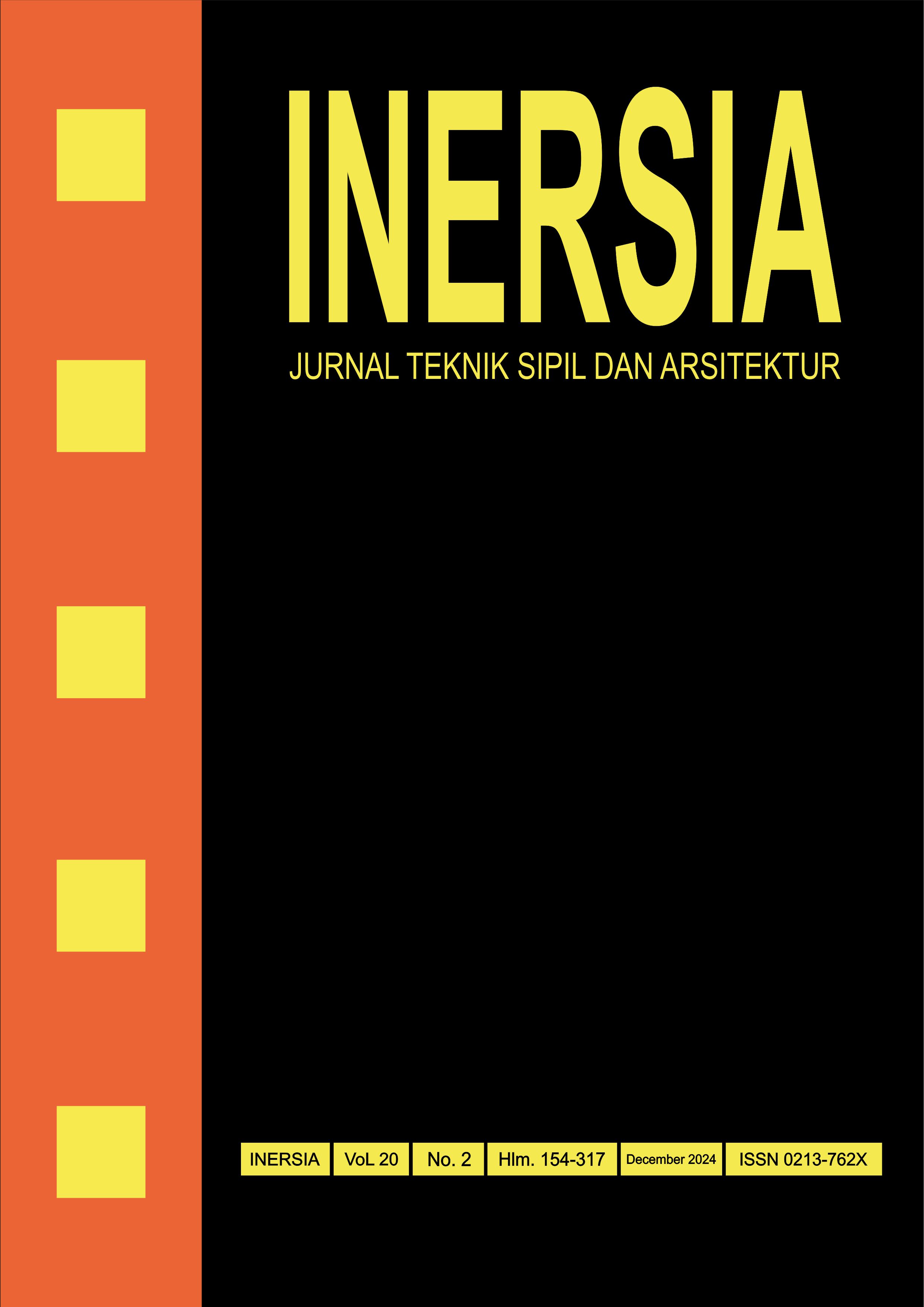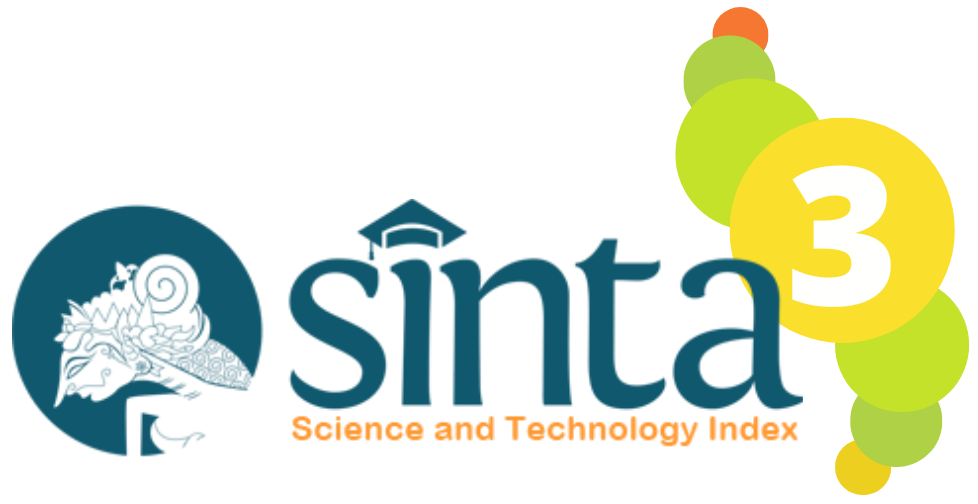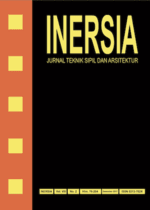Analysis of Peak Ground Acceleration (PGA) and Modified Mercalli Intensity (MMI) Scale using PSHA Method in Lampung Province
DOI:
https://doi.org/10.21831/inersia.v20i2.73063Keywords:
Earthquake, Lampung, PSHA, PGA, MMIAbstract
Earthquakes are inevitable natural disasters that are challenging to predict, yet effective mitigation is crucial. Lampung Province, located in Indonesia, faces significant tectonic activity due to the Sumatra Fault System (SFS) and the subduction of the Indo-Australian and Eurasian plates. Its strategic location as the gateway to Sumatra Island further underscores the importance of understanding earthquake hazards in the region. This study analyzes earthquake risks in Lampung Province using a micro-scale approach that integrates Peak Ground Acceleration (PGA) and Modified Mercalli Intensity (MMI) values through the PSHA method. The PSHA method identifies earthquake microzonations and generates PGA values that are then converted to the MMI scale to determine the intensity of earthquake strength. The mapping of Lampung Province identified five zones with different levels of earthquake hazard, ranging from VII to XI MMI with varying PGA values. The first zone, on the VII MMI scale, has a PGA ranging from 0.20 to 0.25g. The second zone, in the VIII MMI scale category with PGA ranging from 0.20 to 0.40g. The third zone, falls within the IX MMI scale category with PGA ranging from 0.40 to 0.70 g. The fourth zone is categorized as X MMI scale with PGA values ranging from 0.70 to 1.00g. The fifth zone, has a scale of XI MMI with a range of PGA values between 1.00 and 2.50 g. Areas with higher PGA and MMI scales indicate a greater potential for severe damage, highlighting the need for targeted mitigation strategies in high-risk zones. These findings provide a foundation for disaster preparedness and urban planning in Lampung Province.
References
R. Tehseen, M. S. Farooq, and A. Abid, "Earthquake prediction using expert systems: A systematic mapping study," Mar. 01, 2020, MDPI. doi: 10.3390/su12062420.
M. Mavrouli, S. Mavroulis, E. Lekkas, and A. Tsakris, "The Impact of Earthquakes on Public Health: A Narrative Review of Infectious Diseases in the Post-Disaster Period Aiming to Disaster Risk Reduction," Microorganisms, vol. 11, no. 2, p. 419, Feb. 2023, doi: 10.3390/microorganisms11020419.
A. Mujetahid, M. Nursaputra, and A. S. Soma, "Monitoring Illegal Logging Using Google Earth Engine in Sulawesi Selatan Tropical Forest, Indonesia," Forests, vol. 14, no. 3, p. 652, Mar. 2023, doi: 10.3390/f14030652.
A. Febriansyah, R. Rianto, A. K. Wardana, and E. R. Fauzi, "Rapid Assessment of Buildings Affected by Earthquake: Case Study in Pidie Jaya, Aceh, Indonesia," Civil Engineering and Architecture, vol. 8, no. 6, pp. 1217–1224, Dec. 2020, doi: 10.13189/cea.2020.080606.
Kementerian Keuangan Republik Indonesia, "Siap Tanggap Hadapi Bencana," Media Keuangan, vol. 14, no. 137, pp. 17–26, 2019.
BNPB, "Data dan Informasi Bencana Indonesia," Badan Nasional Penanggulangan Bencana, Jakarta: Badan Nasional Penanggulangan Bencana, 2020.
Peratuaran Pemerintah Republik Indonesia, "PP Nomor 21 Tahun 2008 Tentang Penyelenggaraan Penggulangan Bencana," 2008.
Y. Yuliastuti, T. Setiadipura, A. B. Wicaksono, E. E. Alhakim, H. Suntoko, and S. Sunarko, "High-resolution probabilistic seismic hazard analysis of West Nusa Tenggara, Indonesia," J Seismol, vol. 25, no. 3, pp. 937–948, Jun. 2021, doi: 10.1007/s10950-021-10000-9.
P. Supendi et al., "Hypocenter relocation of the aftershocks of the Mw 7.5 Palu earthquake (September 28, 2018) and swarm earthquakes of Mamasa, Sulawesi, Indonesia, using the BMKG network data," Geosci Lett, vol. 6, no. 1, p. 18, Dec. 2019, doi: 10.1186/s40562-019-0148-9.
P. Iqbal, D. A. Wibowo, P. D. Raharjo, H. Lestiana, and E. Puswanto, "The great sumatran fault depression at West Lampung District, Sumatra , Indonesia as geomorphosite for geohazard tourism," GeoJournal of Tourism and Geosites, vol. 47, no. 2, pp. 476–485, Jun. 2023, doi: 10.30892/gtg.47214-1046.
Y. Zhang et al., "Seismic hazard maps based on Neo-deterministic Seismic Hazard Assessment for China Seismic Experimental Site and adjacent areas," Eng Geol, vol. 291, p. 106208, Sep. 2021, doi: 10.1016/j.enggeo.2021.106208.
D. Gentana, N. Sulaksana, E. Sukiyah, and E. T. Yuningsih, "Index of Active Tectonic Assessment: Quantitative-based Geomorphometric and Morphotectonic Analysis at Way Belu Drainage Basin, Lampung Province, Indonesia," Int J Adv Sci Eng Inf Technol, vol. 8, no. 6, pp. 2460–2471, Dec. 2018, doi: 10.18517/ijaseit.8.6.6089.
BPS, "Luas Wilayah di Pulau Sumatera 2015," BPS Provinsi Bengkulu. Accessed: Mar. 22, 2024. [Online]. Available: https://bengkulu.bps.go.id/indicator/153/179/1/luas-wilayah-di-pulau-sumatera.html
BPS Provinsi Lampung, "Proyeksi Penduduk Kabupaten Kota Provinsi Lampung 2020-2035 Hasil Sensus Penduduk 2020," Hasil Sensus Penduduk, 2020.
Afnimar, "Seismologi." Accessed: Apr. 30, 2024. [Online]. Available: https://onesearch.id/Record/IOS3504.libra-115511116000181?widget=1
N. A. Pino, V. Convertito, J. M. Gaspar-Escribano, and R. Wen, "Editorial: Source and Effects of Light to Moderate Magnitude Earthquakes," Front Earth Sci (Lausanne), vol. 9, Dec. 2021, doi: 10.3389/feart.2021.822481.
G. M. Atkinson, D. W. Eaton, and N. Igonin, "Developments in understanding seismicity triggered by hydraulic fracturing," Nat Rev Earth Environ, vol. 1, no. 5, pp. 264–277, May 2020, doi: 10.1038/s43017-020-0049-7.
S. Keil, J. Wassermann, and H. Igel, "Single-station seismic microzonation using 6C measurements," J Seismol, vol. 25, no. 1, pp. 103–114, Feb. 2021, doi: 10.1007/s10950-020-09944-1.
M. Moscatelli, D. Albarello, G. Scarascia Mugnozza, and M. Dolce, "The Italian approach to seismic microzonation," Bulletin of Earthquake Engineering, vol. 18, no. 12, pp. 5425–5440, Sep. 2020, doi: 10.1007/s10518-020-00856-6.
H. Kurnio, A. Fekete, F. Naz, C. Norf, and R. Jí¼pner, "Resilience learning and indigenous knowledge of earthquake risk in Indonesia," International Journal of Disaster Risk Reduction, vol. 62, p. 102423, Aug. 2021, doi: 10.1016/j.ijdrr.2021.102423.
R. Djalante, "Review article: A systematic literature review of research trends and authorships on natural hazards, disasters, risk reduction and climate change in Indonesia," Natural Hazards and Earth System Sciences, vol. 18, no. 6, pp. 1785–1810, Jun. 2018, doi: 10.5194/nhess-18-1785-2018.
S. Kurniawan, D. D. Warnana, and J. P. Gya Nur Rochman, "Pemetaan kerawanan bencana gempa bumi dengan metode PSHA periode ulang 2500 tahun studi kasus pulau Lombok - Nusa Tenggara Barat," Jurnal Geosaintek, vol. 5, no. 3, p. 109, Dec. 2019, doi: 10.12962/j25023659.v5i3.5387.
M. C. Gerstenberger et al., "Probabilistic Seismic Hazard Analysis at Regional and National Scales: State of the Art and Future Challenges," Jun. 01, 2020, Blackwell Publishing Ltd. doi: 10.1029/2019RG000653.
A. Wang, S. Li, J. Lu, H. Zhang, B. Wang, and Z. Xie, "Prediction of PGA in earthquake early warning using a long short-term memory neural network," Geophys J Int, vol. 234, no. 1, pp. 12–24, Feb. 2023, doi: 10.1093/gji/ggad067.
S. Rahpeyma, B. Halldorsson, B. Hrafnkelsson, R. A. Green, and S. Jónsson, "Site effect estimation on two Icelandic strong-motion arrays using a Bayesian hierarchical model for the spatial distribution of earthquake peak ground acceleration," Soil Dynamics and Earthquake Engineering, vol. 120, pp. 369–385, May 2019, doi: 10.1016/j.soildyn.2019.02.007.
A. Abarca, R. Monteiro, G. O'Reilly, E. Zuccolo, and B. Borzi, "Evaluation of intensity measure performance in regional seismic risk assessment of reinforced concrete bridge inventories," Structure and Infrastructure Engineering, vol. 19, no. 6, pp. 760–778, Jun. 2023, doi: 10.1080/15732479.2021.1979599.
J. Zhuang, J. Peng, X. Zhu, and W. Huang, "Scenario-Based Risk Assessment of Earthquake Disaster Using Slope Displacement, PGA, and Population Density in the Guyuan Region, China," ISPRS Int J Geoinf, vol. 8, no. 2, p. 85, Feb. 2019, doi: 10.3390/ijgi8020085.
B. Silitonga, "Pengukuran Seismik Dengan Metode HVSR Untuk Pendugaan Bencana Gempa Bumi," Jurnal Rekayasa Konstruksi Mekanika Sipil (JRKMS), vol. 5, no. 2, pp. 103–111, Oct. 2022, doi: 10.54367/jrkms.v5i2.2184.
E. Alam, "A Modified Mercalli Intensity map of Bangladesh: a proposal for zoning of earthquake hazard," Front Earth Sci (Lausanne), vol. 11, Jul. 2023, doi: 10.3389/feart.2023.1187176.
BNPB, "Definisi Bencana," 2016.
BPS, "Jumlah Penduduk (Jiwa), 2020-2022," BPS Provinsi Lampung. Accessed: Apr. 24, 2024. [Online]. Available: https://lampung.bps.go.id/indicator/12/45/1/jumlah-penduduk.html
N. Ramadanisa and N. Triwahyuningtyas, "Analisis Faktor Yang Mempengaruhi Indeks Pembangunan Manusia Di Provinsi Lampung," SIBATIK JOURNAL: Jurnal Ilmiah Bidang Sosial, Ekonomi, Budaya, Teknologi, dan Pendidikan, vol. 1, no. 7, pp. 1049–1061, 2022, doi: 10.54443/sibatik.v1i7.121.
USGS, "Peta Katalog Gempa Provinsi Lampung Periode 2010-2014 ." Accessed: Mar. 22, 2024. [Online]. Available: https://earthquake.usgs.gov/earthquakes/map/?extent=-7.19882,101.66207&extent=-2.95932,109.28109
Pusat Studi Gempa Nasional (Indonesia) and Pusat Penelitian dan Pengembangan Perumahan dan Permukiman (Indonesia), Peta Sumber dan Bahaya Gempa Indonesia Tahun 2017. 2017.
A. Jaya Syahbana, G. Lambang Goro, O. Fajar Saputra, D. Damara Aditramulyadi, M. Irsyam, and M. Asrurifak, "Application of Modified PSHA USGS Software in Java Island Bed Rock Peak Ground Acceleration and Hazard Curve with 2475 Years Return Period," International Journal of Advanced Science and Technology, vol. 29, no. 7, pp. 3138–3148, 2020.
P. B. Ramadhanu and A. T. Priandika, "Rancang bangun web service API aplikasi sentralisasi produk UMKM pda UPTD PLUT KUMKM provinsi Lampung," Jurnal Teknologi dan Sistem Informasi (JTSI), vol. 2, no. 1, pp. 59–64, 2021, [Online]. Available: http://jim.teknokrat.ac.id/index.php/JTSI
M. Pagani, K. Johnson, and J. Garcia Pelaez, "Modelling subduction sources for probabilistic seismic hazard analysis," Geological Society, London, Special Publications, vol. 501, no. 1, pp. 225–244, Jan. 2021, doi: 10.1144/SP501-2019-120.
Md. Z. Rahman, S. Siddiqua, and A. S. M. M. Kamal, "Seismic source modeling and probabilistic seismic hazard analysis for Bangladesh," Natural Hazards, vol. 103, no. 2, pp. 2489–2532, Sep. 2020, doi: 10.1007/s11069-020-04094-6.
C. Lynner, "Anisotropy-revealed change in hydration along the Alaska subduction zone," Geology, vol. 49, no. 9, pp. 1122–1125, Sep. 2021, doi: 10.1130/G48860.1.
T. Lay, L. Ye, Z. Wu, and H. Kanamori, "Macrofracturing of Oceanic Lithosphere in Complex Large Earthquake Sequences," J Geophys Res Solid Earth, vol. 125, no. 10, Oct. 2020, doi: 10.1029/2020JB020137.
R. Indri, H. Taunaumang, and F. Reynol Tumimomor, "Analisis Bahaya Gempa Bumi Menggunakan Metode Probabilistic Seismic Hazard Analysis Di Wilayah Likupang, Minahasa Utara," Jurnal FisTa : Fisika dan Terapannya, vol. 3, no. 1, pp. 34–38, 2022.
A. H. Khaliq, M. Waseem, S. Khan, W. Ahmed, and M. A. Khan, "Probabilistic seismic hazard assessment of Peshawar District, Pakistan," Journal of Earth System Science, vol. 128, no. 1, p. 6, Feb. 2019, doi: 10.1007/s12040-018-1028-y.
B. Bradley, M. Cubrinovski, and F. Wentz, "Probabilistic seismic hazard analysis of peak ground acceleration for major regional New Zealand locations," Bulletin of the New Zealand Society for Earthquake Engineering, vol. 55, no. 1, pp. 15–24, Mar. 2022, doi: 10.5459/bnzsee.55.1.15-24.
D. M. Boore, J. P. Stewart, E. Seyhan, and G. M. Atkinson, "NGA-West2 Equations for Predicting PGA, PGV, and 5% Damped PSA for Shallow Crustal Earthquakes," Earthquake Spectra, vol. 30, no. 3, pp. 1057–1085, Aug. 2014, doi: 10.1193/070113EQS184M.
B. Chiou, R. Darragh, N. Gregor, and W. Silva, "NGA Project Strong-Motion Database," Earthquake Spectra, vol. 24, no. 1, pp. 23–44, Feb. 2008, doi: 10.1193/1.2894831.
N. Abrahamson, N. Gregor, and K. Addo, "BC Hydro Ground Motion Prediction Equations for Subduction Earthquakes," Earthquake Spectra, vol. 32, no. 1, pp. 23–44, Feb. 2016, doi: 10.1193/051712EQS188MR.
J. X. Zhao et al., "Timing of Late Holocene Paleoearthquakes on the Northern San Andreas Fault at the Fort Ross Orchard Site, Sonoma County, California," Bulletin of the Seismological Society of America, vol. 96, no. 3, pp. 1012–1028, Jun. 2006, doi: 10.1785/0120050123.
C. K. Keshri and W. K. Mohanty, "Next generation ground-motion prediction equations for Indo-Gangetic Plains, India," Journal of Earth System Science, vol. 132, no. 2, p. 85, May 2023, doi: 10.1007/s12040-023-02092-3.
K. W. Campbell, Y. Bozorgnia, N. Kuehn, and N. Gregor, "Empirical nonlinear site effects in Japanese megathrust earthquakes," Earthquake Spectra, vol. 38, no. 4, pp. 2500–2520, Nov. 2022, doi: 10.1177/87552930221111817.
M. Waseem, M. Farooq, Q. Ali, M. Erdik, and S. Hussian, "Updated probabilistic seismic hazard assessment of Pakistan," Natural Hazards, vol. 117, no. 3, pp. 2187–2218, Jul. 2023, doi: 10.1007/s11069-023-05920-3.
C. Bessette and S. Yniesta, "Assessment of the prediction of ground motion parameters in 1D ground response analysis using data from seismic arrays and centrifuge experiments," Earthquake Spectra, vol. 39, no. 2, pp. 1140–1165, May 2023, doi: 10.1177/87552930221150828.
BMKG, "Skala MMI (Modified Mercalli Intensity)." Accessed: Apr. 24, 2024. [Online]. Available: https://www.bmkg.go.id/gempabumi/skala-mmi.bmkg
M. Muzli, M. Masturyono, J. Murjaya, and M. Riyadi, "Studi awal penyusunan skala intensitas gempabumi Badan Meteorologi Klimatologi dan Geofisika," Jurnal Meteorologi dan Geofisika, vol. 17, no. 2, 2016.
B. Gutenberg and C. F. Richter, "Frequency of earthquakes in California," Bulletin of the Seismological society of America, vol. 34, no. 4, pp. 185–188, 1944.
I. W. Astuti, S. Hasmi, I. B. Putra, I. Semuel Erari, and J. Fisika, "Tingkat risiko gempa bumi di kabupaten Nabire berdasarkan nilai percepatan tanah maksimum metode donovan," 2023.
M. Caprio, B. Tarigan, C. B. Worden, S. Wiemer, and D. J. Wald, "Ground motion to intensity conversion equations (GMICEs): A global relationship and evaluation of regional dependency," Bulletin of the Seismological Society of America, vol. 105, no. 3, pp. 1476–1490, 2015.
K. Du, B. Ding, H. Luo, and J. Sun, "Relationship between peak ground acceleration, peak ground velocity, and macroseismic intensity in Western China," Bulletin of the Seismological Society of America, vol. 109, no. 1, pp. 284–297, Feb. 2019, doi: 10.1785/0120180216.
Downloads
Published
How to Cite
Issue
Section
License
Authors who publish with INERSIA journal agree to the following terms:
- Authors retain copyright and grant the INERSIA journal right of first publication with the work simultaneously licensed under Creative Commons Attribution License (CC BY 4.0) that allows others to share the work with an acknowledgment of the work's authorship and initial publication in this journal.
- Authors can enter into separate, additional contractual arrangements for the non-exclusive distribution of the published version of the work (e.g., post it to an institutional repository or edit it in a book), with an acknowledgment of its initial publication in this journal.
- Authors are permitted and encouraged to post their work online (e.g., in institutional repositories or on their website) before and during the submission process, as it can lead to productive exchanges, as well as earlier and greater citation of published work.

INERSIA by https://journal.uny.ac.id/index.php/inersia was distributed under a Creative Commons Attribution 4.0 International License











